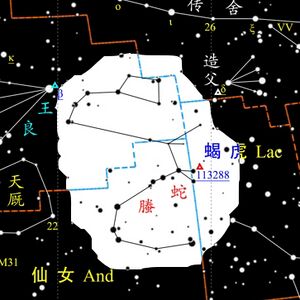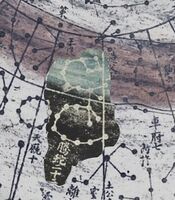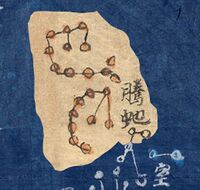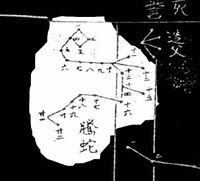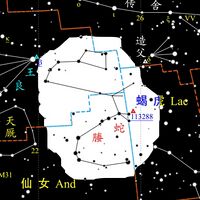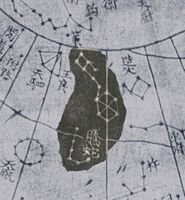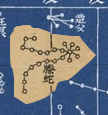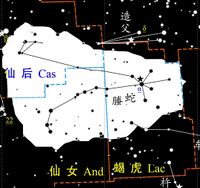Tengshe: Difference between revisions
Boshunyang (talk | contribs) No edit summary |
No edit summary |
||
| Line 232: | Line 232: | ||
</gallery> |
</gallery> |
||
== IAU WGSN Discussion == |
|||
In the discussion of name proposals for the star alf Lac, it was mentioned that the star may be part of the Chinese asterism 螣蛇 (''Téng Shé'') which consists of 22 stars. From Han dynasty onwards, alpha Lacertae was considered the primary star of this constellation. However, most recent research has proven that earlier versions of the Shi Shi Xingjing Star Catalog considered the variable star V242 Lac (HIP 113288, HR 8726) as the principle star. Therefore, WGSN adopts the name Tengshe for this red supergiant with a Vmag of 4.95 ([https://simbad.cds.unistra.fr/simbad/sim-id?Ident=V424+Lac&NbIdent=1&Radius=2&Radius.unit=arcmin&submit=submit+id SIMBAD]), varying between 4.91 and 5.0 mag ([https://www.aavso.org/vsx/index.php?view=detail.top&oid=17013 VSX]). |
|||
==References == |
==References == |
||
Revision as of 17:09, 12 September 2024
Tengshe螣蛇 or 腾蛇 (Téng Shé, Flying Serpent) is a constellation created by ancient Chinese astrologers, dating back to the 2nd century BCE. It is classified as one of the "internal" constellations (内官) of the Shi School (石氏), as it belongs to the Shi School's constellation system during the Han Dynasty, and it is inside of the 28 lunar mansions.
Etymology and History
Tengshe is a mythical flying snake in ancient Chinese folklore, with numerous references found in classical Chinese literature. For instance, the Xunzi荀子 mentions, "螣蛇无足而飞(The Tengshe flies without legs)", and Cao Cao’s famous poem "《龟虽寿》Though the Tortoise Lives Long" includes the line, "神龟虽寿,犹有竟时。螣蛇乘雾,终为土灰(The divine tortoise, though it lives long, will eventually die; the Tengshe rides the mist, yet will eventually turn to dust)", indicating that Tengshe is a legendary creature as well-known as the divine tortoise. Zhang Heng’s "《思玄赋》Ode to Returning to Immortality" describes many constellations, with lines like "玄武缩于壳中兮,螣蛇蜿而自纠(The Xuanwu retracts into its shell, while the Tengshe coils upon itself)", where the Xuanwu is the divine tortoise or a combination of tortoise and snake, representing the northern constellation of the Four Symbols, corresponding to the seven mansions of the north. Tengshe here might also refer to the constellation associated with this celestial creature.
The "《天官书》Treatise on Celestial Offices" does not mention Tengshe, suggesting that this constellation might have been incorporated into the Shishi constellation system only after the Taichu(104-102BCE) reformation to the constellations. The 《石氏星经》Shishi Xingjing (Master Shi's Star Canon or The Shi School's Star Canon) records that this constellation comprises 22 stars, located north of the lunar mansion Shi(室, Room). It states, "When this constellation are bright, there is unrest; when faint, there is peace," indicating that this constellation is generally dim.
The Shishi Xingjing describes the Tengshe constellation as a male serpent that mates with turtles, serving as the leader of aquatic creatures. This further highlights the connection between Tengshe and the tortoise. Some believe that the establishment of this constellation was intended to compensate for the lack of a serpent in the Northern Symbol Xuanwu (with the mansions Xu(虚, Ruins) and Wei(危, Roof) forming the shape of a tortoise), thereby making the image of the Black Tortoise in the Northern Symbol more complete.[1]
Identification of stars
The Cheonsang Yeolcha Bunyajido Star Chart, the Dunhuang Star Chart, and the Geziyuejintu document the shapes of constellations during the Tang dynasty and earlier periods, and these three early star charts share significant similarities, but they differ considerably from star charts created after the Song dynasty, like Suzhou star map. In these earlier star charts, Tengshe (the flying serpent) is depicted with two heads, while in post-Song dynasty star charts, Tengshe is shown with a single head. According to the Han dynasty’s Shi School's Star Catalog (or Master Shi's Star Catalogue), the star associated with Tengshe's beak star(螣蛇喙星) corresponds to V424 Lac (HIP 113288). However, in later single-headed depictions, the central major star(中央大星) of Tengshe is α Lac, indicating a shift in the constellation’s position over time.
| Star Names or Orders(Traditional/Qing) | Ho PENG YOKE[2] | Yi Shitong[3]
Based on catalogue in 18th century |
Pan Nai[4]
based on Xinyixiangfayao Star Map |
SUN X. & J. Kistemaker[5]
Han Dynasty |
Boshun Yang[6]
before Tang dynasty |
Boshun Yang[7]
Song Hingyou(1052) |
|---|---|---|---|---|---|---|
| Primary Star(central star or beak star) | beta Lac | alpha Lac | alpha Lac | alpha Lac | HIP 113288 | alpha Lac |
| epsilon Cep | 4 Lac | 9 Lac | 9 Lac | HIP 113327 | beta Lac | |
| mu Cep | pi2 Cgy | beta Lac | beta Lac | 3 And | HIP 109521 | |
| pi1 Cgy | pi1 Cgy | HIP 109521 | 4 Lac | 7 And | 4 Lac | |
| pi2 Cgy | ? | 4 Lac | 2 Lac | 8 And | 5 Lac | |
| 4 Lac | HIP 105064 | 5 Lac | 5 Lac | 11 And | HIP 113288 | |
| HIP 111550 | HIP 106886 | HIP 113327 | 3 And | lambda And | 9 Lac | |
| 9 Lac | 13 Cep | HIP 113288 | 7 And | kappa And | HIP 113501 | |
| HIP 114162 | epsilon Cep | 3 And | 8 And | iota And | HIP 114162 | |
| HIP 114924 | beta Lac | HIP 114714 | 11 And | 10 And | HIP 114924 | |
| HIP 117133 | sigma Cas | 18 And | lambda And | omicron And | HIP 118077 | |
| rho Cas | rho Cas | HIP 118077 | psi And | HIP 113501 | sigma Cas | |
| tau Cas | tau Cas | sigma Cas | kappa And | HIP 112641 | rho Cas | |
| HIP 113288 | AR Cas | rho Cas | iota And | HIP 114162 | HIP 117299 | |
| 3 And | 9 Lac | tau Cas | 6 Lac | HIP 114924 | HIP 116912 | |
| 7 And | 3 And | AR Cas | 10 Lac | sigma Cas | 3 And | |
| 8 And | 7 And | 5 And | 12 Lac | rho Cas | 7 And | |
| 11 And | 8 And | 7 And | 13 Lac | tau Cas | 8 And | |
| lambda And | lambda And | 8 And | 14 Lac | AR Cas | 11 And | |
| psi And | psi And | 11 And | omicron And | HIP 115395 | lambda And | |
| kappa And | kappa And | lambda And | 15 Lac | 1 Cas | kappa And | |
| iota And | iota And | kappa And | 11 Lac | HIP 114622 | iota And | |
| iota And | ||||||
| 15 And |
Star Maps
- Tengshe
IAU WGSN Discussion
In the discussion of name proposals for the star alf Lac, it was mentioned that the star may be part of the Chinese asterism 螣蛇 (Téng Shé) which consists of 22 stars. From Han dynasty onwards, alpha Lacertae was considered the primary star of this constellation. However, most recent research has proven that earlier versions of the Shi Shi Xingjing Star Catalog considered the variable star V242 Lac (HIP 113288, HR 8726) as the principle star. Therefore, WGSN adopts the name Tengshe for this red supergiant with a Vmag of 4.95 (SIMBAD), varying between 4.91 and 5.0 mag (VSX).
References
- ↑ Xu Gang徐刚, Wang Yangping王燕平. 星空帝国:中国古代星宿揭秘Xingkongdiguo: Zhongguo Gudai Xingxiu Jiemi. Beijing: Renmin Youdian Chubanshe北京:人民邮电出版社.2016. P138.
- ↑ P.-Y. Ho, “Ancient And Mediaeval Observations of Comets and Novae in Chinese Sources,” Vistas in Astronomy, 5(1962), 127-225.
- ↑ Yi Shitong伊世同. Zhongxi Duizhao Hengxing Tubiao中西对照恒星图表1950. Beijing: Science Press.1981: 71-72.
- ↑ Pan Nai潘鼐. Zhongguo Hengxing Guance shi中国恒星观测史[M]. Shanghai: Xuelin Pree. 2009. p304.
- ↑ Sun Xiaochun. & Kistemaker J. The Chinese sky during the Han. Leiden: Brill. 1997, Pp241-6.
- ↑ B.-S. Yang杨伯顺, Zhongguo Chuantong Hengxing Guance Jingdu ji Xingguan Yanbian Yanjiu 中国传统恒星观测精度及星官演变研究 (A Research on the Accuracy of Chinese Traditional Star Observation and the Evolution of Constellations), PhD thesis, (Hefei: University of Science and Technology of China, 2023). 269.
- ↑ B.-S. Yang杨伯顺, Zhongguo Chuantong Hengxing Guance Jingdu ji Xingguan Yanbian Yanjiu 中国传统恒星观测精度及星官演变研究 (A Research on the Accuracy of Chinese Traditional Star Observation and the Evolution of Constellations), PhD thesis, (Hefei: University of Science and Technology of China, 2023). 269.
